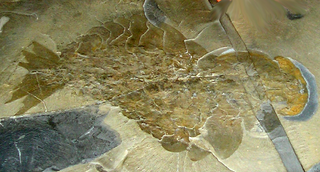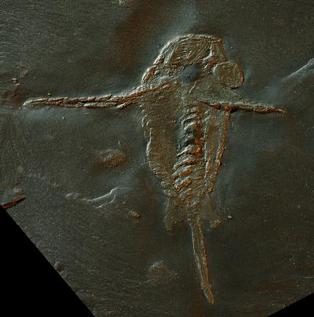 W
WAmplectobelua is an extinct genus of late Early Cambrian amplectobeluid radiodont, a group of stem arthropods that mostly lived as free-swimming predators during the first half of the Paleozoic Era.
 W
WAmplectobeluidae is a clade of Cambrian radiodonts.
 W
WAnomalocarididae is an extinct family of Cambrian radiodonts, a group of stem-group arthropods.
 W
WAnomalocaris is an extinct genus of radiodont (anomalocaridid), an order of animals thought to be closely related to ancestral arthropods. The first fossils of Anomalocaris were discovered in the Ogygopsis Shale by Joseph Frederick Whiteaves, with more examples found by Charles Doolittle Walcott in the Burgess Shale. Originally several fossilized parts discovered separately were thought to be three separate creatures, a misapprehension corrected by Harry B. Whittington and Derek Briggs in a 1985 journal article. Anomalocaris is thought to be one of the earliest examples of an apex predator, though others have been found in older Cambrian lagerstätten deposits.
 W
WCaryosyntrips ("nutcracker") is an extinct genus of radiodont which existed in Canada and the United States during the middle Cambrian. Caryosyntrips is known only from a handful of 14-segmented frontal appendages, which resemble nutcrackers, recovered from the Burgess Shale Formation. It was first named by Allison C. Daley, Graham E. Budd in 2010 and the type species is Caryosyntrips serratus.
 W
WCucumericrus decoratus is a species of putative radiodont known from a few poorly preserved specimens. Only fragments of trunk cuticle and corresponded appendages had been revealed, while important radiodont features such as frontal appendages are unknown in this species. The trunk cuticle possess irregular wrinkles and may had been soft in life. Each of the trunk appendage compose of a dorsal flap-like element and a ventral stubby leg with unknown distal region, structurally comparable to the trunk appendages of gill lobopodians and euarthropod biramous appendages. The legs have been interpreted as somewhere between annulated lobopod legs and segmented arthropod legs.
 W
WHurdia is an extinct genus of hurdiid radiodont that lived 505 million years ago during the Cambrian Period. As a radiodont like Peytoia and Anomalocaris, it is part of the ancestral lineage that led to euarthropods.
 W
WLyrarapax is a radiodont genus of the family Amplectobeluidae that lived in the early Cambrian period 520 million years ago. Its neural tissue indicates that the radiodont frontal appendage is protocerebral, resolving parts of the arthropod head problem and showing that the frontal appendage is homologous to the antennae of Onychophorans and labrum of euarthropods. Its fossilized remains were found in Yunnan in southwestern China. A second species was described in 2016, differing principally in the morphology of its frontal appendages.
 W
WParanomalocaris is a genus of primitive radiodont recovered from eastern Yunnan. It contains a single species, Paranomalocaris multisegmentalis. It is only known from its frontal appendage. The frontal appendage features endites with numerous auxiliary spines, and at least 22 segments (podomeres), hence the specific name multisegmentalis.
 W
WPeytoia is a genus of hurdiid radiodont that lived in the Cambrian period, containing two species, Peytoia nathorsti and Peytoia infercambriensis. Its two frontal appendages had long bristle-like spines, it had no fan tail, and its short stalked eyes were behind its large head.
 W
WPeytoia infercambriensis is a species of hurdiid formerly assigned to the genus Cassubia. It is known from drillcore material that was collected from the Lower Cambrian of Kashubia, Poland at 4.8 kilometres depth.
 W
WPeytoia nathorsti is a species of hurdiid radiodont from the Burgess Shale. It is the type species of the genus Peytoia.
 W
WRamskoeldia is a genus of amplectobeluid radiodont described in 2018. It was the second genus of radiodont found to possess gnathobase-like structures and an atypical oral cone after Amplectobelua. It was discovered in the Chengjiang biota of China, the home of numerous radiodontids such as Amplectobelua and Lyrarapax.
 W
WSchinderhannes bartelsi is a species of hurdiid radiodont (anomalocaridid) known from one specimen from the lower Devonian Hunsrück Slates. Its discovery was astonishing because previously, radiodonts were known only from exceptionally well-preserved fossil beds (Lagerstätten) from the Cambrian, 100 million years earlier.
 W
WStanleycaris is an extinct, monotypic genus of hurdiid radiodont which existed in Canada, during the middle Cambrian (Miaolingian). The type species is Stanleycaris hirpex. Stanleycaris was described from the Stephen Formation near the Stanley Glacier Burgess Shale locality and also informally reported from Odaray Mountain.
 W
WTamisiocaris is a radiodont genus initially only known from frontal appendages from the Buen Formation in Sirius Passet. Further specimens revealed that the frontal appendages were segmented and bore densely-packed auxiliary spines, which were adapted to suspension feeding in a manner analogous to modern baleen whales.
 W
WTitanokorys is a genus of extinct hurdiid radiodont that existed during the middle part of the Cambrian. It is the largest member of its family from the Cambrian, with a body length of 50 centimeters long, making it one of the largest animals of the time. It bears a resemblance to a related genus Cambroraster. Based on the shape of its appendages, Titanokorys is speculated to have used them to sift through the sand looking for prey.